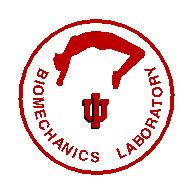


 Dapena, J. and C.S. Chung. Vertical and radial motions of the body during the take-off phase of high jumping. Med. Sci. Sports Exerc. 20:290-302, 1988.
Dapena, J. and C.S. Chung. Vertical and radial motions of the body during the take-off phase of high jumping. Med. Sci. Sports Exerc. 20:290-302, 1988.
By placing the muscles of the takeoff leg in faster eccentric or slower concentric conditions, a high jumper can increase the ground reaction force and the height of the jump. Film analysis of seven high jumpers showed that the radial velocity of the center of mass with respect to the supporting foot was more negative or less positive than the vertical velocity throughout the takeoff phase. This favored faster eccentric or slower concentric conditions of the leg muscles. The radial distance from the hip of the takeoff leg to the center of mass (RG/H) first decreased by 0.030 m, due to negative radial motions of the arms and swinging leg. This contributed to a smaller negative radial velocity of the hip (VRH), and thus to slower eccentric conditions of the muscles of the takeoff leg. Therefore, it may have helped to cushion the initial impact with the ground. Subsequently, RG/H increased by 0.120 m, due to positive radial velocities of the arms, the swinging leg, and the head and trunk. This contributed first to larger negative (and later to smaller positive) VRH values, and thus to faster eccentric and slower concentric conditions of the muscles of the takeoff leg.
Last updated: March 1996
URL: http://www.indiana.edu/~sportbm/abstract-hjvertrad88.html
Comments: 
Copyright
1996, The Trustees of Indiana University